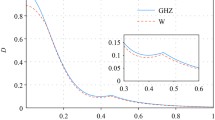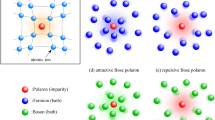Abstract
The hypothesis (Sparenberg et al. in EPJ Web Conf 58:01016, [1]. https://doi.org/10.1051/epjconf/20135801016) that the particular linear tracks appearing in the measurement of a spherically-emitting radioactive source in a cloud chamber are determined by the (random) positions of atoms or molecules inside the chamber is further explored in the framework of a recently established one-dimensional model (Carlone et al. Comm Comput Phys 18:247, [2]. https://doi.org/10.4208/cicp.270814.311214a). In this model, meshes of localized spins 1/2 play the role of the cloud-chamber atoms and the spherical wave is replaced by a linear superposition of two wave packets moving from the origin to the left and to the right, evolving deterministically according to the Schrödinger equation. We first revisit these results using a time-dependent approach, where the wave packets impinge on a symmetric two-sided detector. We discuss the evolution of the wave function in the configuration space and stress the interest of a non-symmetric detector in a quantum-measurement perspective. Next we use a time-independent approach to study the scattering of a plane wave on a single-sided detector. Preliminary results are obtained, analytically for the single-spin case and numerically for up to 8 spins. They show that the spin-excitation probabilities are sometimes very sensitive to the parameters of the model, which corroborates the idea that the measurement result could be determined by the atom positions. The possible origin of decoherence and entropy increase in future models is finally discussed.





Similar content being viewed by others
Notes
The present apparatus hidden variables are thus standard physical quantities. They are “hidden”, in the sense that they are not easily accessible experimentally, but they are not “hidden variables” of the kind postulated by Einstein, Podolsky and Rosen [3], which would have a different—and unknown—nature.
References
Sparenberg, J.-M., Nour, R., Manço, A.: EPJ Web Conf. 58, 01016 (2013). https://doi.org/10.1051/epjconf/20135801016
Carlone, R., Figari, R., Negulescu, C.: Comm. Comput. Phys. 18, 247 (2015). https://doi.org/10.4208/cicp.270814.311214a
Einstein, A., Podolsky, B., Rosen, N.: Phys. Rev. 47, 777 (1935)
Mott, N.F.: The wave mechanics of alpha-ray tracks. Proc. R. Soc. A126, 79 (1929). Also available in [15]
Mott, N.F., Alexandrov, A.S. (eds.): Sir Nevill Mott, 65 years in Physics. World Scientific, Singapore (1995)
Barra, F., Gaspard, P.: Scattering in periodic systems: from resonances to band structure. J. Phys. A 32, 3357 (1999)
Anderson, P.W.: Phys. Rev. 109, 1492 (1958)
Dell’Antonio, G.F.: Found. Phys. 45, 11 (2015). https://doi.org/10.1007/s10701-014-9850-9
Cacciapuoti, C., Carlone, R., Figari, R.: Spin-dependent point potentials in one and three dimensions. J. Phys. A 40, 249 (2007)
Figari, R., Teta, A.: Quantum Dynamics of a Particle in a Tracking Chamber. Springer, Berlin (2014). https://doi.org/10.1007/978-3-642-40916-5
Figari, R., Teta, A.: From quantum to classical world: emergence of trajectories in a quantum system. Math. Mech. Compl. Syst. 4, 235 (2016). https://doi.org/10.2140/memocs.2016.4.235
Bethe, H.: Ann. Phys. 397, 325 (1930). https://doi.org/10.1002/andp.19303970303
Beceiro-Novo, S., Ahn, T., Bazin, D., Mittig, W.: Prog. Part. Nucl. Phys. 84, 124 (2015). https://doi.org/10.1016/j.ppnp.2015.06.003
Kirkby, J., et al.: Ion-induced nucleation of pure biogenic particles. Nature 533, 521 (2016). https://doi.org/10.1038/nature17953
Allahverdyan, A.E., Balian, R., Nieuwenhuizen, T.M.: Understanding quantum measurement from the solution of dynamical models. Phys. Rep. 525, 1 (2013). https://doi.org/10.1016/j.physrep.2012.11.001
Acknowledgements
This text presents research results of the IAP program P7/12 initiated by the Belgian-state Federal Services for Scientific, Technical, and Cultural Affairs. We thank Ruben Ceulemans (KU Leuven) for useful discussions and for the check of our numerical results.
Author information
Authors and Affiliations
Corresponding author
Rights and permissions
About this article
Cite this article
Sparenberg, JM., Gaspard, D. Decoherence and Determinism in a One-Dimensional Cloud-Chamber Model. Found Phys 48, 429–439 (2018). https://doi.org/10.1007/s10701-018-0155-2
Received:
Accepted:
Published:
Issue Date:
DOI: https://doi.org/10.1007/s10701-018-0155-2




